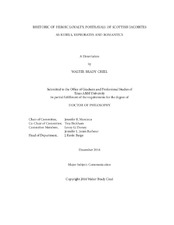| dc.description.abstract | The Scottish Jacobite tradition spans a tumultuous arc of history in which imagery of Highland dress — tartan and kilts — was used to portray Highland Scots as enemies of the British state and as heroes of the British Empire. This dissertation analyzes historical artifacts bearing the rhetoric that accompanied the development and evolution of Scottish identity after 1745. By leveraging Kenneth Burke’s theory of dramatism and victimage rituals, this research explains how rhetorical portrayals of Scots in tartan — by anti-Jacobites, by critics of George III and by revisionist romantics — transformed and redeemed Scottish Jacobite identity from defiant “otherness” (dangerous renegades and rebels) to integrated Britishness (loyal subjects and servants of the Empire) in the eighteenth and nineteenth centuries.
From the Glorious Revolution of 1688 onward, Jacobites, loyal to the deposed James II and his heirs, endeavored to restore their rightful Stuart kings to the throne. Hanoverians portrayed Jacobites as a dangerous and existential threat to the peace, prosperity and perpetuity of a new British way of life. Jacobites were vilified through propaganda that employed cartoons, caricatures and mocking dialogue to belittle Scots loyal to the Stuarts and to undermine their cause. Scottish tartan and associated garb became a visual marker of these usurpers. When their quest was finally crushed at the Battle of Culloden in 1746, defeat was followed by systematic ethnocide — a legislative mandate from London that the Highland identity be recast in a shape that was unquestionably loyal to the crown, absolutely indifferent toward the Stuarts, and forever incapable of waging war except in the service of the king.
Amid diminishing threat of Jacobite insurrection and Britain’s increasing preoccupation with global preeminence, Highlanders demonstrated their loyalty to Britain through military service to imperial ambitions. Meanwhile, with growing discontent with perceived corruption and cronyism in the court and governments of George III, anti-Jacobite rhetoric became a principal weapon against the king. This shift — adoption of anti-Jacobite rhetoric against targets other than Jacobites — along with the incubation of a new sense of integrated Scottishness, gave birth to a new identity for Highland Scots that largely constitutes present-day perception of Scotland. | en |


